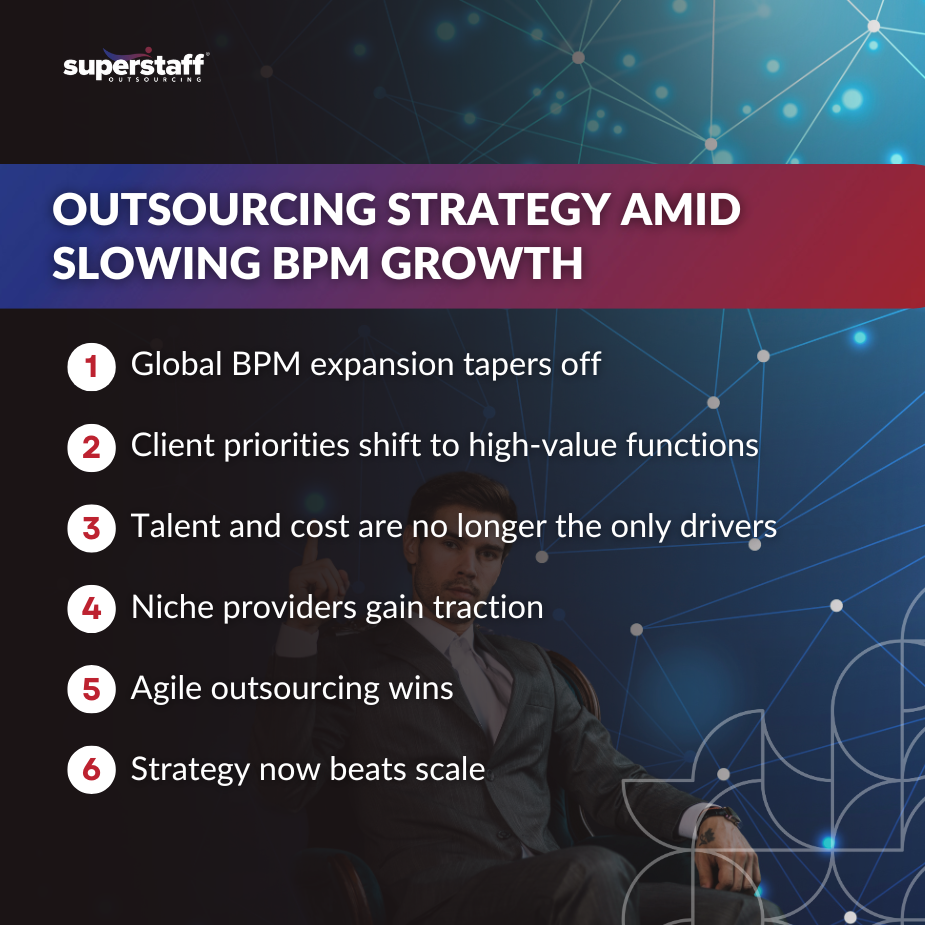
The Business Process Management slowdown is drawing more attention as companies begin to rethink how they structure their back-office functions. Once a high-growth area for operational transformation, BPM is now stabilizing, with businesses moving more cautiously. Rising costs, increased automation, and changing client expectations are contributing to a clear shift.
This slowdown doesn’t mean BPM is no longer useful. Instead, it signals a transition—a point where businesses must reassess strategies, tools, and outsourcing partnerships. Let’s take a closer look at what’s driving the trend and how companies can move forward with greater clarity.

Key Reasons Behind the Business Process Management Slowdown
Multiple factors are influencing the global Business Process Management slowdown. Each one has long-term implications for how companies structure their outsourcing models and workflows.
1. Automation Reducing Manual Workloads
Many companies now rely on software to handle routine tasks once managed through BPM systems. The impact of automation on BPM growth is significant, especially in data entry, reporting, and customer communication. This shift has removed the need for complex BPM structures in some business units.
2. Rising Operational Costs
Maintaining BPM tools and staff can be costly. Licensing software, training teams, and integrating multiple platforms add up. These rising costs are making companies second-guess continued investments in BPM frameworks.
3. Complexity Slows Implementation
As BPM platforms become more robust, implementation takes longer. Businesses are frustrated with delays and disruption, especially when faster solutions like outsourcing can deliver results more quickly.
4. Focus on Core Business Over Processes
Instead of refining internal processes through BPM, companies are leaning on third-party experts to handle operations. This shift has caused a reduced demand for internal BPM setups and more interest in flexible, outsourced support.
5. Vendor Fatigue
With dozens of BPM vendors offering similar tools, decision-makers are overwhelmed. The result? Slower adoption and declining growth. Many businesses delay BPM projects or turn to simpler outsourcing options.
How the BPM Slowdown Affects Outsourcing Strategy
The Business Process Management slowdown has forced a reset in outsourcing plans. Companies are looking for more practical, cost-efficient ways to stay competitive.
1. From In-House to Outsourced Solutions
Fewer firms are maintaining in-house BPM teams. Instead, they are hiring outsourcing providers who offer built-in workflows and service frameworks. This trend helps them avoid BPM costs while achieving operational goals.
2. Preference for Managed Services
Outsourcing partners offering end-to-end solutions are now preferred over DIY BPM systems. Managed services remove the burden of implementation, monitoring, and compliance from the client side.
3. Greater Demand for Agility
The reasons for BPM growth include slow deployment. In contrast, outsourcing providers offer quick onboarding and flexible scaling, which helps businesses adapt without long project cycles.
4. Narrower Focus in Partner Selection
Rather than adopting broad BPM programs, companies are choosing outsourcing partners who specialize in a single function, like billing, HR, or tech support. This targeted approach leads to faster results and less complexity.
5. Cost-Effectiveness Becomes the Deciding Factor
With BPM becoming more expensive, outsourcing offers a lower-risk, lower-cost way to improve operations. Businesses are prioritizing partners who can deliver measurable outcomes with fewer resources.
Adjusting to the Shift: What Businesses Should Do
Organizations facing the Business Process Management slowdown need a clear plan for adapting. This doesn’t mean abandoning structure, it means choosing structure that fits current needs.
1. Assess What Still Needs BPM
Not every process requires outsourcing. Businesses should assess which tasks truly benefit from structured management and which ones can be shifted to a vendor.
2. Re-Evaluate BPM Investments
If BPM costs are rising but returns are falling, it’s time to review spending. Companies should track performance against outcomes to determine whether it still makes sense to maintain or expand BPM tools.
3. Explore Function-Specific Outsourcing
For areas like finance, tech support, and data entry, specialized outsourcing firms may be better suited than a full BPM rollout. These providers often offer faster results and fewer setup delays.
4. Train Teams to Work With Outsourcing Partners
Even when moving away from BPM, internal staff still need process knowledge. Training employees to coordinate with outsourcing teams improves communication and efficiency.
5. Focus on Outcomes, Not Just Process
Whether using BPM or outsourcing, the end goal is performance. Businesses should set clear KPIs and track results, rather than getting bogged down in process details.
Long-Term Impacts of BPM’s Slower Growth
The Business Process Management slowdown will continue to shape how companies organize workflows and delegate tasks. These changes are more than temporary; they reflect a permanent shift in priorities.
1. BPM Will Become a Niche Tool
Rather than being the go-to framework, BPM may be used only for highly regulated industries or complex workflows. This will free up resources for businesses to invest in outsourced partnerships.
2. Outsourcing Will Gain More Ground
As BPM usage declines, outsourcing will fill the gap. Providers that offer speed, flexibility, and cost savings are likely to win long-term contracts.
3. Strategic Planning Will Change
The BPM slowdown affects outsourcing decisions by forcing leaders to think beyond internal tools. Long-term strategies will rely more on external support for non-core processes.
4. Tech Stack Will Get Simpler
Companies are moving away from layered tech stacks that BPM often requires. Instead, they prefer simple, vendor-managed platforms that reduce IT load and streamline data access.
5. Greater Role of Data in Decision-Making
Even as BPM declines, data-driven decision-making remains important. Outsourcing partners who provide real-time insights and reporting will become key assets to business operations.
Rethinking BPM for a Leaner Strategy
- Business Process Management slowdown is reshaping operational thinking
- Outsourcing offers a faster, cost-effective solution
- Partner with experts like SuperStaff for scalable support
As the Business Process Management slowdown continues, companies must rethink how they manage routine operations. Rather than relying on complex in-house systems, many are turning to providers like SuperStaff for more flexible solutions.
SuperStaff supports growing companies with outsourcing services that simplify workflows, reduce overhead, and deliver consistent performance. Whether you’re scaling operations, improving customer support, or exploring new markets, we can help you stay ahead.
Let SuperStaff support your next move. Reach out today.






